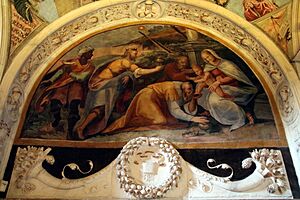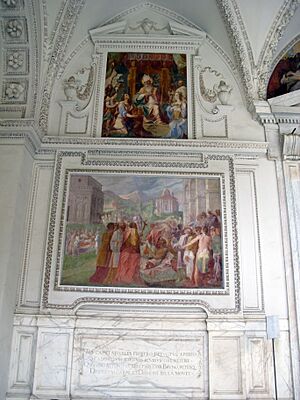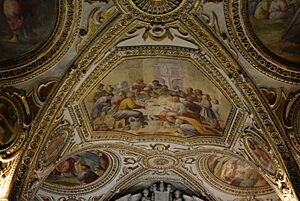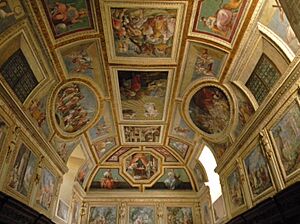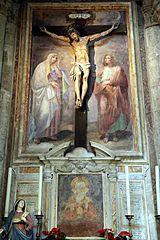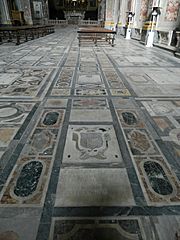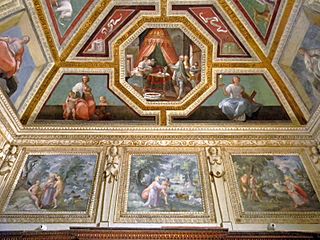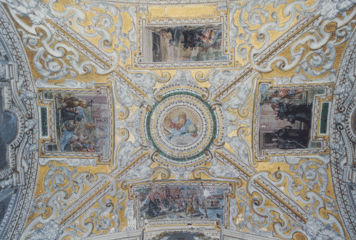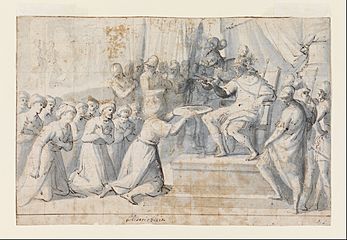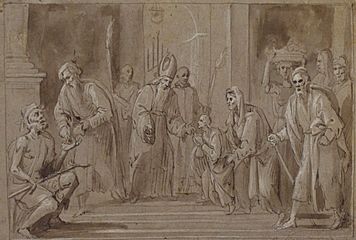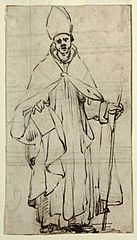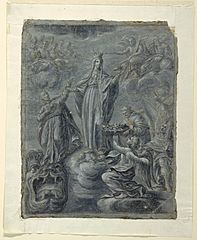Belisario Corenzio facts for kids
Quick facts for kids
Belisario Corenzio
|
|
|---|---|
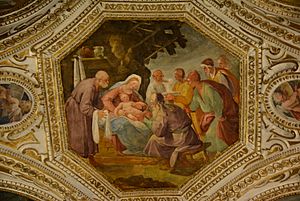
The Virgin and Child
|
|
| Born | 1558 Kyparissia, Greece
|
| Died | 1646 (aged 87–88) Esperia, Italy
|
| Resting place | Tomb at Santi Severino e Sossio |
| Nationality | Greek |
| Education | Apprentice to Tintoretto |
|
Notable work
|
Frescos Crypt of Matthew |
| Style | Mannerism |
| Movement | Italian Renaissance Italian Baroque |
Belisario Corenzio (1558–1646) was a talented Greek-Italian painter. He worked mostly in the cities of Venice and Naples. Unlike many Greek painters of his time, he did not follow the Cretan School style. Instead, he adopted the Venetian style of art.
Corenzio was taught by the famous Venetian painter Tintoretto. He was sometimes called Il Greco, which means "The Greek." In 1590, when he was 32, Corenzio moved to Naples and stayed there for the rest of his life. He became very well-known for his fresco paintings, which are paintings done on wet plaster walls or ceilings. Many of his frescos can still be seen today in churches like Santi Severino e Sossio and Certosa di San Martino. He also painted the crypt at Salerno Cathedral, showing scenes from the Gospel of Matthew. His drawings are kept in museums around the world, including the Metropolitan Museum and the Louvre.
About Belisario Corenzio
Belisario Corenzio was born in a city called Arcadia, which is now Kyparissia, in Greece. By the age of 12, he was already living in the Kingdom of Naples, which was then part of the Spanish Empire. His family was part of the Greek community in Naples and was quite wealthy. His father and uncle were important members of the Spanish community.
According to some stories, Corenzio was sent to learn painting by John of Austria, a famous military leader. In the 1580s, Corenzio moved to Venice and spent five years studying art with Tintoretto. Venice had a large Greek community at that time, and many Greek painters worked there.
After his studies, Corenzio returned to Naples in 1590 and set up his own busy art workshop. An art historian named Bernardo de' Dominici wrote a lot about Corenzio in his book published in 1742. Dominici said that Corenzio was an incredibly talented painter who could paint very quickly. However, Dominici also believed that Corenzio sometimes painted for money rather than for the art itself.
Dominici also wrote that Corenzio could be very jealous of other artists. He was known for his strong personality. Corenzio formed a group with two other famous painters, Jusepe de Ribera and Battistello Caracciolo. This group was sometimes called the "Cabal of Naples." For hundreds of years, there have been many rumors about this group. Some stories say they tried to stop other painters from getting jobs in Naples. These stories are just rumors and don't have strong proof.
Corenzio continued to paint many frescos in churches all over Naples. Some of his most important works are in Salerno Cathedral, Santi Severino e Sossio, and Santissima Annunziata Maggiore, Naples. He also taught many students how to paint frescos, including Onofrio De Lione, Massimo Stanzione, and Andrea di Leone.
There are also different stories about how Corenzio died. One rumor says he fell from scaffolding while fixing a fresco in a church. Another story suggests he poisoned himself. He was one of the most talked-about and celebrated artists of his time. His tomb can be found at Santi Severino e Sossio.
His Artworks
Corenzio's earliest known works date back to the 1590s. He painted the Medici Chapel in Gragnano, which is part of the Santi Severino e Sossio church, and also works in the Certosa di San Martino. Around 1603, he painted two frescos in the basilica of Santa Maria a Parete in Liveri, near Naples. One of these large frescos shows scenes of the Dance of Death, Judgment, Hell, and Heaven.
He also painted parts of the Castel Capuano around 1608. In 1609, he decorated the ceilings of the nave, transept, and choir in the church of Santi Severino e Sossio. By 1615, he had frescoed the ceiling of the apse in the church of Santa Maria di Costantinopoli.
Corenzio worked for many years in the church of Santa Maria la Nova, where he frescoed the ceiling. He also created four large paintings for the Santa Maria Del Popolo church, showing scenes like Christmas and the Epiphany.
He spent his later years in the village of Esperia and passed away in 1646 at 88 years old. He completed countless artworks throughout his long career.
Corenzio was an important member of the Greek community in Naples. He completed frescos in the Santi Pietro e Paolo dei Greci church, which served the local Greek Orthodox people. A street in Naples, called Via Belisario Corenzio, is named after him.
Gallery
Paintings
Drawings
Important Works
Belisario Corenzio created many important artworks, especially frescos in churches and palaces. Here are some of his notable works:
- Frescos in the Chapel Vault of Palazzo Diomede Carafa Naples, Italy
- Frescos in Salerno Cathedral Salerno Italy
- Frescos in Santi Severino e Sossio Naples, Italy
- Frescos in Santissima Annunziata Maggiore, Naples, Italy
- Frescos in Santa Maria di Costantinopoli, Naples, Italy
- Frescos in Santa Maria la Nova, Naples, Italy
- Frescos in Certosa di San Martino, Naples, Italy
- Frescos in Gesù Nuovo, Naples, Italy
- Frescos in the Royal Palace of Naples, Naples, Italy
- Frescos in the Church of Santa Patrizia, Naples, Italy
- Frescos in the Chapel Vault of Monte di Pietà, Naples
- Frescos on the Interior Ceiling of Santa Maria della Sapienza, Naples, Italy
- Frescos of the Assumption of the Virgin with a choir of Angels (1613) in Santa Teresa degli Scalzi, Naples, Italy
- Frescos of Cloister Gospel Stories in Santa Maria degli Angeli alle Croci Via Veterinaria Naples Italy
- Frescos in Santa Maria di Monteverginella, Naples, Italy
- Frescos in the Crypt of Santi Apostoli, Naples
- Frescos in the Sanctuary of St. Francis and St. Anthony, Cava de 'Tirreni Salerno, Italy
- Frescos of San Lazzaro, Trinity with the Madonna and the Angels in Santa Maria di Piedigrotta, Naples, Italy
- Frescos in Santi Pietro e Paolo dei Greci (Naples, Italy)
- Frescos in San Paolo Maggiore, Naples, Italy
- Frescoes of the Wedding at Cana in San Gregorio Armeno, Naples, Italy
- Frescoes of the Stories of St. Francis in Santa Chiara, Naples, Naples, Italy
- Eternal Father in San Domenico Maggiore, Naples, Italy
- Works in Girolamini, Naples
- Works in the Church of the Annunciation Nola, Italy
- Five Canvases in Palazzo Ricca, Naples
- Works in Santa Maria a Parete Liveri Naples, Italy
- Works in Castel Capuano
- Works in Santa Maria Del Popolo
See also
 In Spanish: Belisario Corenzio para niños
In Spanish: Belisario Corenzio para niños
- Fresco Painting
- Michelangelo
- Eustathios Karousos


